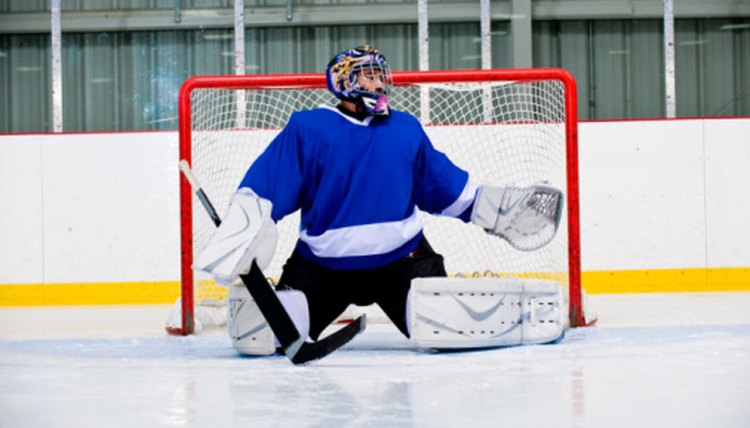How to Make My Goalie Pads Rotate

Hockey goaltenders who use the butterfly style require their pads to rotate forward as they drop to their knees, so the pads continue to face the shooter and puck. Most modern flat-front or box-style butterfly pads are designed to assist in the rotation process. However, proper strapping is necessary to ensure the pads are not too tight on the goaltender's legs.
Center the pad over your skate. Tie the toe ties through the front or back holes under the skate cowling. Leave enough slack for the pad to stay on your boot when you recover from the butterfly save, but not so tight as to restrict rotation.
Tighten the strap around the skate, just tight enough to secure the pad. Tighten the second strap under the skate boot in the same manner.
Tighten the next two straps up over the ankle and calf in the same manner as the boot straps. Remember to allow enough slack to allow the pad to rotate forward as your ankles drop into the butterfly.
Fasten the knee lock strap snugly, but not tight. Leave the knee strap just loose enough so you can feel it, but not tight. Leave the upper thigh strap loose, or remove it entirely by pulling it through the pad. Note that your straps are progressively looser as they go up the pad.
Test the rotation by dropping into the butterfly. Remember to drive your knees down together. Do not hop into the position, as this will cause the pads to end up face-down.
Fine-tune the strapping on the pad, until the pad rotates forward as you drop into the butterfly. Loosen or tighten the ankle and calf straps as needed if the pad fails to return to the forward-facing position upon recovery.
Tips
You should never have to push the pads back to their forward-facing position after recovering from the butterfly. Pad adjustment is required if this continues to happen.
Slimmer knee pads restrict pad rotation less.
If you have leather straps, circle the proper adjustment hole with a paint pen or fine-tip marker for quick reference.
Every pad and leg is different. Trial and error is often required until the perfect fit is achieved.
References
Tips
- You should never have to push the pads back to their forward-facing position after recovering from the butterfly. Pad adjustment is required if this continues to happen.
- Slimmer knee pads restrict pad rotation less.
- If you have leather straps, circle the proper adjustment hole with a paint pen or fine-tip marker for quick reference.
- Every pad and leg is different. Trial and error is often required until the perfect fit is achieved.
Writer Bio
David Lipscomb is a professional writer and public relations practitioner. Lipscomb brings more than a decade of experience in the consumer electronics and advertising industries. Lipscomb holds a degree in public relations from Webster University.
